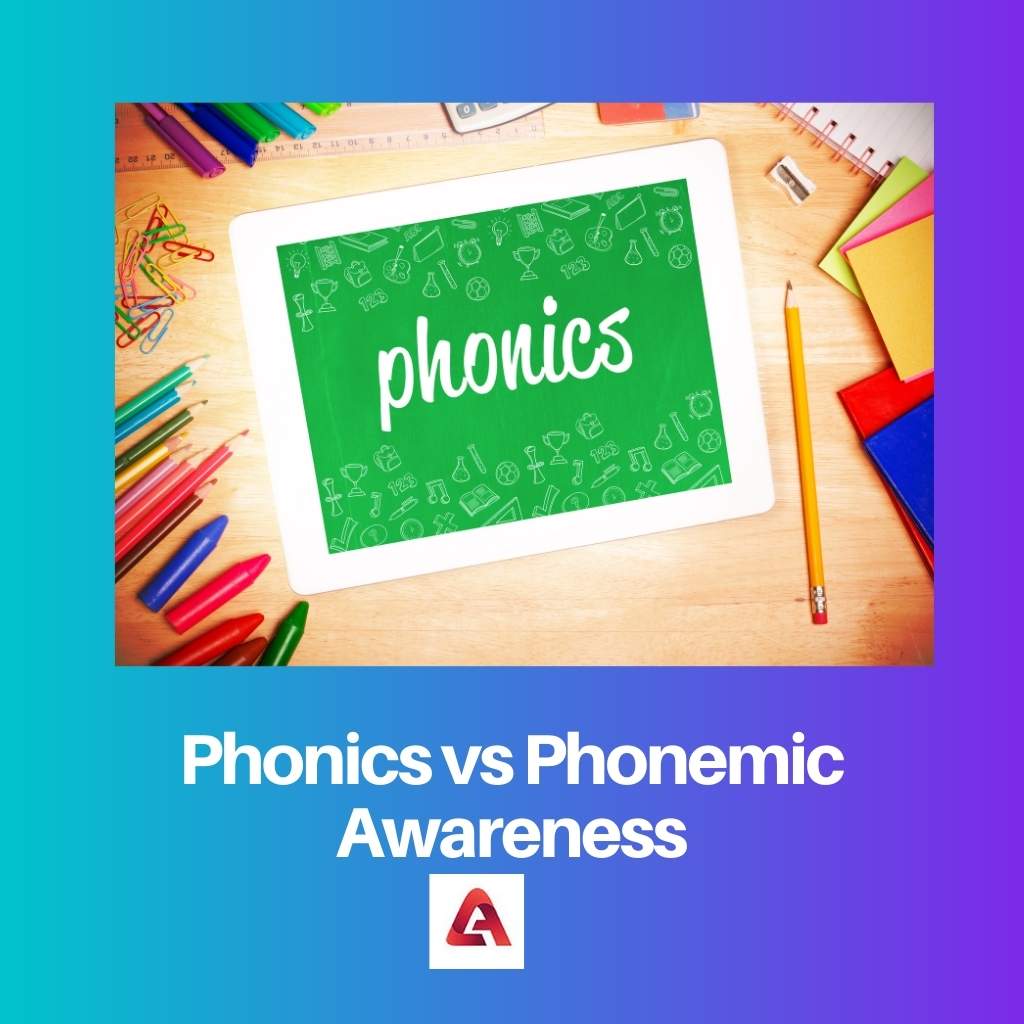Phonics is an important aspect of early childhood literacy and one of the building blocks of learning to read and write.
Although phonemic awareness may appear to be the same thing, and both are crucial to learning a language, there are significant differences between the two.
When introducing youngsters’ words, a firm base for complex language skills is built by emphasizing both phonics and phonemic awareness.
Key Takeaways
- Phonics studies the relationship between sounds and letters, while phonemic awareness is identifying and manipulating individual sounds in spoken words.
- Phonics focuses on decoding written words, while phonemic awareness focuses on oral language.
- Phonics instruction begins with the alphabet, while phonemic awareness instruction begins with rhyming, blending, and segmenting.
Phonics vs Phonemic Awareness
Phonics is the method of teaching, reading and writing by correlating sounds with letters. With phonemes, a learner copes with sound, spelling and phonological structure. Phonological awareness refers to the ability to recognise and work with the sounds of language. A learner manipulates the sounds in spoken language.

The pairing of sounds (phonemes) with written alphabet letters is known as phonics. The phonics coding system is being used to translate the original text into sounds when reading (decoding).
The very same phonic coding mechanism can be used to covert sounds perceived into characters to generate written words in spelling.
Our potential to break words down into their lowest sound components (individual phonemes) and alter these sounds via segmentation, mixing, replacement, re-ordering, and removal is known as phonemic awareness.
This is focused on what we listen and say rather than on what we read.
Comparison Table
| Parameters of Comparison | Phonics | Phonemic Awareness |
|---|---|---|
| Definition | The sound and letter correlations are referred to as phonics. It has to do with the relationship between sounds and written symbols. | Phonological awareness includes phonemic awareness. |
| Function | The alphabetic principle—the written representation of speech is taught. | The ability to decipher the oral language. |
| Focus | Focuses on written language and print. | Focuses on spoken skills. |
| Learning via | Visual and auditory | Mostly auditory |
| Individuals deal with | sounds, spelling patterns, and phonological structure when reading and writing letters. | manipulation of sounds and the conversion of sounds into words. |
What is Phonics?
Phonics is one of the various ways of teaching that may be used to teach a student or learner how to read English.
It is considered the beginning of good reading since it involves connecting individual letters or letter groupings of the alphabet with their corresponding sound(s).
Joining the sound “k” with the letters “k,” “c,” and even “CK” a, when the latter appears on the board, is a brilliant example. Students are learning to mix letter sounds to obtain hidden pronunciations of complex words in phonics.
Students learn the letter or letter pairings that reflect the 44 sounds or phonemes in the English language through formal phonics training.
Learners can merge or modify sounds to read and understand words once they understand the sounds that the characters they see in print create.
Learners hear the entire word, divide it into sounds, and then correlate the letter or letter pairings to the sound they produce when spelling.
The English language is too uncertain, according to critics of explicit phonics education, and learners should acquire to “read” words using context or visual signals rather than pronouncing them out.
While English isn’t always predictable, it is indeed an alphabetic language with a lot of predictability. 84 percent of English words have a consistent phonetic pattern.

What is Phonemic Awareness?
Phonemic Awareness is the recognition that spoken words are composed of separate sounds known as phonemes. Phonemic awareness is both oral and auditory, with an emphasis on the sounds of words.
Phonemic awareness is frequently mistaken with phonics, but, unlike phonics, phonemic awareness does not require the use of printing or letter names.
Phonemic awareness training teaches learners that the words they perceive in oral language are not complete units but rather co-articulated sounds that comprise a word.
Once students comprehend this concept, we can have them separate, mix, divide, and alter the sounds. These phonemic awareness abilities are required for becoming a skilled and fluent reader.
Blending is a fundamental phonemic awareness ability that directly links to phonic decoding or sounding out words.
When we mix, we extract the pieces (sounds) and combine them to form a complete word. For instance, the sounds /s/ /u/ /n/ together form the word sun.
Segmenting is a fundamental phonemic awareness function. Segmenting is similar to mixing and is closely related to encoding or spelling.
When we separate, we take the entire word and divide it into sections. Once anyone has letter-sound information, they can split the word “plan” into all of the phonemes, /p/ /l/ /a/ /n/, and spell that word (phonics).

Main Differences Between Phonics and Phonemic Awareness
- Phonics depends on the way sounds look in print, while Phonemic Consciousness understands that every word consists of a succession of sounds.
- The majority of phonics teaching is written, whereas the majority of Phonemic Awareness sessions are delivered orally.
- Phonics education is both visual and auditory, whereas Phonemic Awareness is mostly auditory.
- People use Phonics to cope with sounds, spelling patterns, and phonological structure, whereas Phonemic Awareness deals with sound manipulation and conversion.
- Phonics includes letter patterns and symbol knowledge, whereas Phonemic Awareness does not. It only includes oral sessions.

Very informative!
I didn’t know the difference between phonics and phonemic awareness. This was a great read.
Phonics and phonemic awareness, while related, are clearly not the same. Thanks for the detailed comparison.
Absolutely, it really helped me understand the differences better.
I agree. This article really sheds light on this topic.
Seems like phonics and phonemic awareness are both necessary to learn a new language. Great article!
Seems like phonics and phonemic awareness are two sides of the same coin.
Wow! You really explained these concepts well. I’m impressed!
I second that. Great job!
Agree! This was very insightful.
I find it fascinating that there’s such a clear distinction between phonics and phonemic awareness.
The difference between phonics and phonemic awareness is key. Thanks for the explanation!